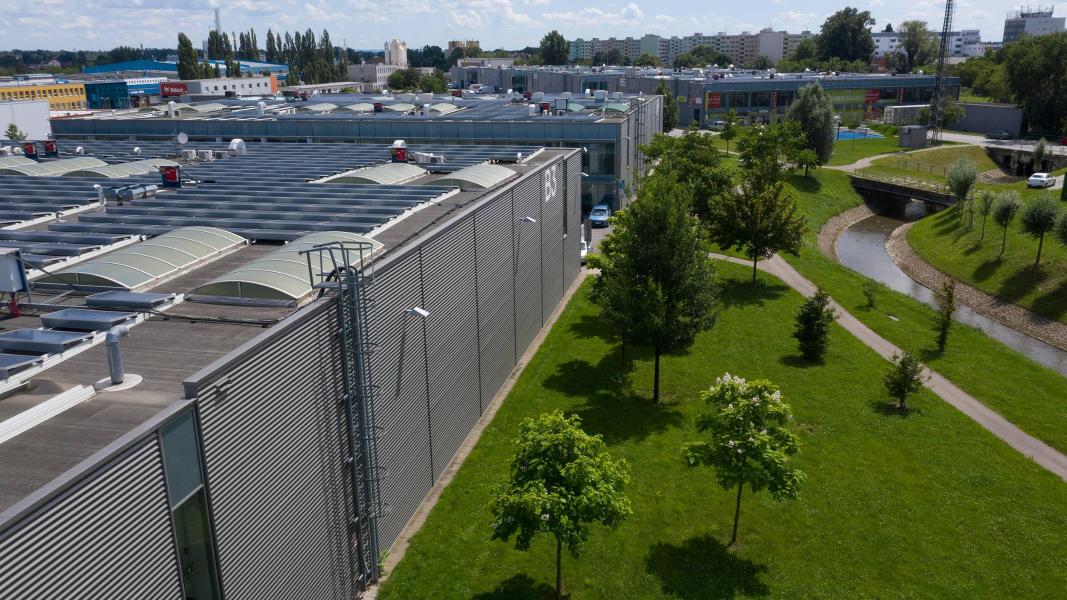Logistics company CTP turns the roofs of its facilities in Czechia and elsewhere into massive solar power farms, cutting costs and emissions for its tenants, and boosting its own profits
Renewable energy can make even the owner of a small house into an electric company – just put some solar panels on your roof and sell the energy you don’t use to your local utility company. For a company with 11 million square metres of rooftop, that makes for a mouth-watering prospect.
Europe’s largest listed logistics property owner and manager, CTP, is covering the roofs of its buildings with solar panels, so that renewable energy will become a substantial part of the company’s business, alongside developing new buildings and operating business parks. The next step in CTP’s move into energy is to put solar panels on the roofs of its buildings in every country in which it operates. It’s a significant stride because, though CTP shares are listed on Euronext Amsterdam, the bulk of its business is in Central and Eastern European countries such as the Czech Republic, Slovakia, Hungary and Romania.
“We see energy as the third business unit within the company,” says Maarten Otte, who heads investor relations from CTP’s Prague office. “Solar is the first step in that, but it goes much further, right on to providing electric-vehicle charging stations for our tenants, energy management, and energy storage.”
The company projects that it will have as much as 400 MWp of capacity on its buildings by the end of 2026. (MWp stands for “megawatt peak,” which is a measure of the output of power from a source that may vary, such as sunshine.) And with plans to double its portfolio and, therefore, its effective roof space in the coming years, CTP could be generating 1 GWp in these countries by the end of the decade. That’s a major step towards the decarbonisation of countries where emissions are still high.
Rooftop solar and European strategic autonomy
CTP’s properties, which are used as logistics centres and by some light industrial clients as venues for production, also provide European locations for companies that might otherwise have been forced to look for space in, for example, Asia, keeping important industries in Europe and shortening supply chains.
“Thanks to its strategic location, skilled employees and favourable cost structure, Central and Eastern Europe is well-positioned to be a manufacturing hub for Europe,” says Jan Morawiec, a loan officer for the European Investment Bank. “CTP is bringing companies back from Asia. It’s contributing to Europe’s strategic autonomy.”
After the industrial supply disruptions caused by the COVID-19 pandemic and the energy shortages that followed Russia’s invasion of Ukraine, this strategic autonomy is crucial to Europe’s future. The strategic contribution is one of the reasons the European Investment Bank, the EU bank, signed a €200 million loan with CTP in September to finance the solar project mainly in the four Central and Eastern European countries. The loan is part of the European Investment Bank’s €45 billion contribution to REPowerEU, the European Union’s plan to reduce dependence on fossil-fuel imports and to hasten the green transition.
That’s because the CTP deal is also a contributor to the green transition. “The penetration of renewables here is low at the moment,” says Morawiec, who’s based in Prague.
And that makes the numbers on this project still more impressive. CTP calculates that on average 1 MWp of solar panel capacity on its roofs leads to an annual cut in carbon dioxide emissions of 500 tonnes, though there are significant differences from country to country. Given the 400 MWp of solar capacity the company expects to have in place by the end of 2026, CTP estimates the project should prevent the emission of around 200 000 tonnes of carbon.
“It’s quite rewarding, personally,” says CTP’s Otte. “As an industry, we can play a leading role in the transition that Europe is going through. We can help Europe be more sustainable and more self-sufficient from a geopolitical perspective.”

Rooftop solar logistics centres – and profit centres
The solar panels are good for the climate. They also make financial sense – for CTP and its tenants. The company estimates it could soon generate – quite literally – up to 10% of its overall profits, if solar panels are installed on all available roofs.
Its manufacturing tenants use energy to operate machinery. They’ll be able to buy the energy from CTP at a lower rate than they pay to utility companies, because they won’t have to pay distribution fees for the grid network. Fleets of vehicles used by the tenant companies will be able to go electric, using charging points fed by energy from the roofs.
“It makes a profit for CTP, plus it gives them a competitive advantage over other logistics companies that don’t integrate energy supply into their rental contracts,” says David González García, lead engineer for energy transition programmes at the European Investment Bank.
“The impact is potentially even bigger,” González García adds, because solar panels on rooftops do not use up the agricultural land that typical solar farms occupy. “They’re not taking away land that could be used for something else. This project takes advantage of the built environment, creating a new use on top of something that’s already useful.”
With many of CTP’s sites in areas far away from capital cities, the project also contributes to the European Investment Bank’s support for EU cohesion objectives, to reduce economic inequalities between regions.
